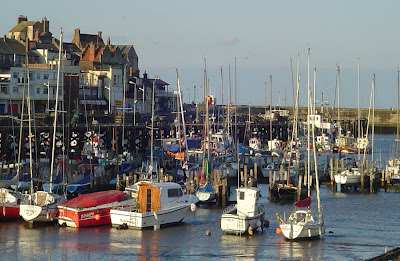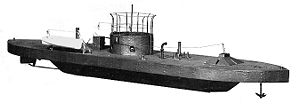The First Glimpse
It first appears as a tiny speck on the horizon, its color almost blending into the sea and sky so that we’re not quite sure if we really saw it or not. We wait a couple of minutes and decide it’s definitely getting bigger. The timing is right, and we keep watching. Now it is unmistakably a ship, and it’s bigger than any other vessel in the tiny, sheltered harbor before us. If this ship were anchored offshore for any length of time, the local fishing boat captains would be taking tourists out to gawk at her (this has actually happened in the past). But the ship has come for us – she is an impressive beauty who has sailed a very long way from home to play a critical role in the search for the BHR. For me, this first sighting of our vessel is always one of the highlights of a new mission – to know that people believe so strongly in what we’re doing that ships have been mobilized on our behalf, and crews are inspired and ready to go.
We are picked up pierside by a much smaller boat, and enjoy an exhilarating 1-mile ride out to the mother ship, our luggage covered in black garbage bags and computers encased in huge ziploc baggies in the event we should take a wave over the side. Transport by small boat is necessary because of the extreme tidal fluctuations on the east coast of England. There are very few ports where the water is deep enough for a medium-to-large-sized ship to come into port. Many of the harbors in this area are known as “dry,” meaning when the tide goes out, there are boats left sitting in the mud until the tide comes in again and re-floats them, like in this photo. It’s nature’s version of drydock, and is just one of the many factors we take into account when planning a mission.
There’s This Bar…
So there is one place in England that I haven’t quite been able to get to during all the port calls in the past several years. In the sleepy small town of Filey, which is south of Flamborough Head, there is a bar called Bonhommes. They brew their own beer and apparently there is a beer named John Paul Jones, and one named Bonhomme Richard. The beer got good reviews from the locals when the bar opened in 2008: “I’ve just had my first batch and it’s gone down a right treat. I’ve been absolutely packed. Filey has been crying out for a local beer for so long. It’s absolutely superb. I really hope it does put us on the map.” Here’s what the bar looks like:
Desperation Breeds Fearlessness
I was talking with someone today who asked how the BHR Project has become all that it has, and don’t I get intimidated by talking to 4-star Admirals and Chiefs of Naval Operations? Thankfully, my civilian status comes in handy, and my ignorance about many things Navy is also very helpful. As a civilian, I can easily approach an Admiral at a social event or conference (e.g. maybe he is the keynote speaker there), introduce myself (or ask for an introduction from someone else), and nothing is really off-limits in the conversation. But underlying all of this is my tongue-in-cheek motto: Desperation breeds fearlessness. If I really need to accomplish something, such as secure a ship of opportunity for the next expedition, I find I am braver in approaching the people who can actually provide support in this capacity, and they are few and far between. Not to mention the task of winning their attention in a crowded room when you have 1-2 minutes to have the conversation. (It’s a good thing I had some practice lobbying in a former life.) So the opportunities are rare, and we have to pounce on them when they arise – there is no time for being intimidated.
The BHR endeavor would have been “dead in the water” in 2008 had it not been for the support of the US and French Navies. It’s also critical that the Navies can accomplish their at-sea objectives as well, such as dive training or testing out new surveying technologies. If the Navy needs to do training, why not conduct that training with the exciting, morale-building theme of finding the BHR?
The Mighty P3 Orion
So what does the mighty P3 Orion aircraft have to do with searching for the BHR? It has been used for the magnetic detection of submarines, reconnaissance missions, and maritime patrols. But will it be effective in locating a sizable iron ballast mound belonging to a Revolutionary warship? We are in the midst of finding out. A P3 flew over our search area to see if it could detect any potential magnetic targets that are not associated with known modern wrecks, pipelines, or other identifiable obstructions. First, a trial run was flown over the wreck of the USS Monitor (below) off the east coast of the U.S. to make sure the magnetometer could detect an older wreck with iron content.
The P3 did detect the Monitor site, so this is encouraging. In any case, this will prove to be more data to add to our collection and will make for an interesting comparison of aerial vs. marine magnetometry in shipwreck searches. My intent is to publish something on this once we have all of our data analyzed. Many thanks to the USN and the flight team who carried out this mission!
A Titanic Search Area
I recently saw the new Titanic exhibit at the Mystic Aquarium, which opened for the 100th Anniversary of the sinking. There is a short movie where Bob Ballard talks about how they searched for the wreck and ultimately found it. He indicated that they had a search area of 150 square miles. This really struck me, and I thought, “I could only DREAM of 150 square miles… try 900!” This is actually the size of our area, given that we do not know exactly what was happening for a 20-hour period right before BHR sank.
Logistics and Speaking Engagements
We are busy these days trying to work out logistics for the mission, which involves who’s going, where ship and personnel transfers are taking place, travel arrangements, equipment checks, and the list goes on and on. Many challenges….how to get US and FR Navy software to “talk” to one another with different equipment, how to bring another 100 or so people up to speed on what the project is about and what we’re looking for. And then there are the fundraising aspects! This mission will be our most complex yet, but could easily be our most productive as well. I am anticipating it to be the biggest challenge of my BHR career, and am really excited about it.
Was thinking today about all of the adventures – from Submarine NR1 in 2008, where I lived with 12 men and four bunks for 5 days, to being one of two women on a FR Navy minehunter, and one of two women on USNS GRASP. Members of the BHR team often are invited to present to various groups…I am waiting for the day when someone asks me to talk about BHR, but from the perspective of what it’s like to be a woman in a man’s world. The stories I could tell…
Mission "Lucky 7"
I should have started this blog in 2006, when the adventure first began….
For those of you unfamiliar with the subject of this blog, please visit www.bonhommerichard.org for background.
I have returned recently from a trip to France to meet with Admiral Bruno Demeocq (FR Navy- pictured right), and accompanied by Admiral Jon White (USN – pictured left). The French Navy is providing tremendous support for the 2012 search for the Bonhomme Richard (BHR), flagship of American Naval hero John Paul Jones. It was from the decks of the BHR that his famous quote was spoken: “I have not yet begun to fight!” during a battle with HMS Serapis during the Revolutionary War. This mission will be the 7th survey in as many years, with some shorter ones in between to investigate targets from year to year. The USN will contribute Autonomous Underwater Vehicles and a team of personnel to the survey.
The project has proven to be a tremendous opportunity for FR-US relations, as well as technology transfer. I never in a million years thought it would be what it is today!



